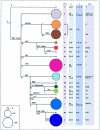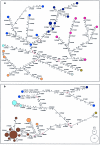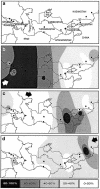A genetic landscape reshaped by recent events: Y-chromosomal insights into central Asia
- PMID: 12145751
- PMCID: PMC419996
- DOI: 10.1086/342096
A genetic landscape reshaped by recent events: Y-chromosomal insights into central Asia
Abstract
Sixteen Y-chromosomal microsatellites and 16 binary markers have been used to analyze DNA variation in 408 male subjects from 15 populations in Central Asia. Large genetic differences were found between populations, but these did not display an obvious geographical or linguistic pattern like that usually seen for Y-chromosomal variation. Nevertheless, an underlying east-west clinal pattern could be detected by the Autocorrelation Index for DNA Analysis and admixture analysis, and this pattern was interpreted as being derived from the ancient peopling of the area, reinforced by subsequent migrations. Two particularly striking features were seen: an extremely high level of Y-chromosomal differentiation between geographically close populations, accompanied by low diversity within some populations. These were due to the presence of high-frequency population-specific lineages and suggested the occurrence of several recent bottlenecks or founder events. Such events could account for the lack of a clear overall pattern and emphasize the importance of multiple recent events in reshaping this genetic landscape.
Figures







Similar articles
-
Y-chromosomal diversity in Europe is clinal and influenced primarily by geography, rather than by language.Am J Hum Genet. 2000 Dec;67(6):1526-43. doi: 10.1086/316890. Epub 2000 Nov 9. Am J Hum Genet. 2000. PMID: 11078479 Free PMC article.
-
Geographical, linguistic, and cultural influences on genetic diversity: Y-chromosomal distribution in Northern European populations.Mol Biol Evol. 2001 Jun;18(6):1077-87. doi: 10.1093/oxfordjournals.molbev.a003879. Mol Biol Evol. 2001. PMID: 11371596
-
A back migration from Asia to sub-Saharan Africa is supported by high-resolution analysis of human Y-chromosome haplotypes.Am J Hum Genet. 2002 May;70(5):1197-214. doi: 10.1086/340257. Epub 2002 Mar 21. Am J Hum Genet. 2002. PMID: 11910562 Free PMC article.
-
Maori origins, Y-chromosome haplotypes and implications for human history in the Pacific.Hum Mutat. 2001 Apr;17(4):271-80. doi: 10.1002/humu.23. Hum Mutat. 2001. PMID: 11295824
-
Messages through bottlenecks: on the combined use of slow and fast evolving polymorphic markers on the human Y chromosome.Am J Hum Genet. 2000 Nov;67(5):1055-61. doi: 10.1016/S0002-9297(07)62935-8. Epub 2000 Oct 6. Am J Hum Genet. 2000. PMID: 11023811 Free PMC article. Review. No abstract available.
Cited by
-
Ancestral Origins and Admixture History of Kazakhs.Mol Biol Evol. 2024 Jul 3;41(7):msae144. doi: 10.1093/molbev/msae144. Mol Biol Evol. 2024. PMID: 38995236 Free PMC article.
-
Origins of East Caucasus Gene Pool: Contributions of Autochthonous Bronze Age Populations and Migrations from West Asia Estimated from Y-Chromosome Data.Genes (Basel). 2023 Sep 9;14(9):1780. doi: 10.3390/genes14091780. Genes (Basel). 2023. PMID: 37761920 Free PMC article.
-
Unveiling 2,000 years of differentiation among Tungusic-speaking populations: a revised phylogeny of the paternal founder lineage C2a-M48-SK1061.Front Genet. 2023 Jul 24;14:1243730. doi: 10.3389/fgene.2023.1243730. eCollection 2023. Front Genet. 2023. PMID: 37554407 Free PMC article.
-
The Genetic Echo of the Tarim Mummies in Modern Central Asians.Mol Biol Evol. 2022 Sep 1;39(9):msac179. doi: 10.1093/molbev/msac179. Mol Biol Evol. 2022. PMID: 36006373 Free PMC article.
-
Mucopolysaccharidosis Type I in the Russian Federation and Other Republics of the Former Soviet Union: Molecular Genetic Analysis and Epidemiology.Front Mol Biosci. 2022 Jan 24;8:783644. doi: 10.3389/fmolb.2021.783644. eCollection 2021. Front Mol Biosci. 2022. PMID: 35141277 Free PMC article.
References
Electronic-Database Information
-
- Ethnologue, http://www.ethnologue.com/ (for Ethnologue languages database)
-
- Fluxus Engineering, http://www.fluxus-engineering.com/sharenet.htm (for NETWORK 3.0 phylogenetic network analysis software)
References
-
- Anthony DW (1986) The “Kurgan culture,” Indo-European origins, and the domestication of the horse: a reconsideration. Curr Anthropol 27:291–313
-
- Bandelt HJ, Forster P, Rohl A (1999) Median-joining networks for inferring intraspecific phylogenies. Mol Biol Evol 16:37–48 - PubMed
-
- Bao W, Zhu S, Pandya A, Zerjal T, Xu J, Shu Q, Du R, Yang H, Tyler-Smith C (2000) MSY2: a slowly evolving minisatellite on the human Y chromosome which provides a useful polymorphic marker in Chinese populations. Gene 244:29–33 - PubMed
Publication types
MeSH terms
Grants and funding
LinkOut - more resources
Full Text Sources


